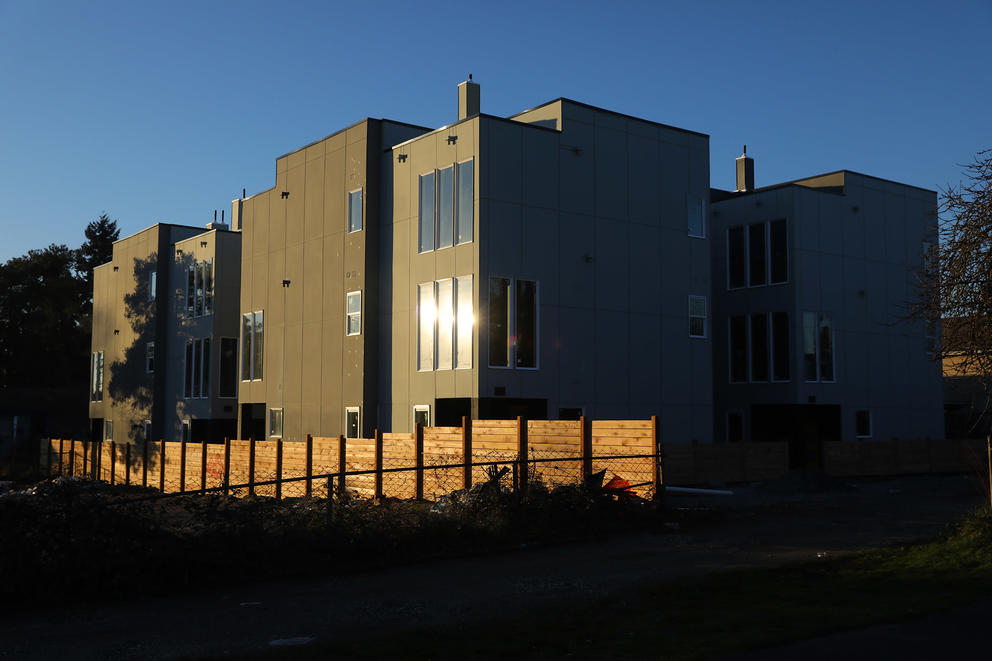Gov. Jay Inslee is taking aim at local zoning restrictions that prevent the construction of housing such as duplexes, fourplexes, townhomes and courtyard apartments in many neighborhoods, including in parts of Seattle. Those types of denser housing, which Inslee’s plan refers to as “missing middle” housing, are banned in many residential areas that right now limit new construction to single-family homes.
Inslee, a Democrat in his third term, said these kinds of local zoning restrictions are fueling an affordable housing crisis throughout the state — a problem that requires immediate statewide action to solve.
“You can’t build housing if you have nowhere to build it,” Inslee said at a press conference Jan. 27. “These artificial restrictions now take off sometimes 80%, 85% of the land where you can build middle housing — housing for teachers, firefighters, truck drivers — housing for our children, who otherwise can’t afford a place to live in a city.”
Supporters of Inslee’s plan said it also will help reduce carbon emissions by helping people live closer to their jobs, shops and businesses, reducing their need to drive.
Leaders in many of the state’s cities however, see Inslee’s proposal as a power grab that undermines their local authority.
Carl Schroeder, lobbyist for the Association of Washington Cities, said in January that although cities throughout Washington aren’t opposed to building a variety of housing types, “by and large, they want to retain the ability to determine how and where it makes sense for them.”
“This bill basically says, ‘Forget all these local considerations, this is how it’s going to be,’ ” said Schroeder, whose organization opposes Inslee’s proposal.
On top of that, others — including the mayor of Seattle and some affordable housing advocates — worry the governor’s plan could lead to more gentrification and displacement, which they fear could disproportionately harm low-income people and communities of color. They worry the proposal would replace existing housing with a larger number of more expensive homes.
“People are hurting desperately right now, and we have so few units of actual affordable housing for working people and low-income folks,” said Michele Thomas, policy director of the Washington Low Income Housing Alliance. “We really are hoping the bill can more specifically focus on affordability.”
The plan Inslee introduced last month would require cities to allow all types of middle housing within a half mile of major transit stops. That would mean allowing sixplexes, stacked flats, townhouses and courtyard apartments in those areas.
Additionally, Inslee’s proposal would require cities of 10,000 and larger to legalize duplexes in all their residential areas, while requiring cities of 20,000 and above to allow construction of fourplexes in all residential zones. As an alternative to this type of blanket upzone, cities could adopt a minimum average density requirement that would apply citywide. The larger the city, the larger the average number of housing units per acre that would be required under this option.
Inslee’s initial proposal has been tweaked some in the Legislature and is likely to change further as it moves through the process. The legislation is advancing as House Bill 1782 in the state House and Senate Bill 5670 in the state Senate; both bills have been voted out of policy committees in their respective chambers.
The House version has been amended the most significantly, including to impose less stringent density requirements. For instance, the amended House measure would no longer require larger cities to allow fourplexes everywhere as one compliance option. And cities wouldn’t need to allow duplexes on smaller lots under 4,500 square feet; they could leave those zoned for single-family homes.
State Rep. Jessica Bateman, an Olympia Democrat who sponsored the House version of Inslee’s proposal, said the idea from the start was to enact “a gentle upzone across the state, to encourage a diffuse absorption of our population statewide.”
Under the proposal, cities could still adopt height limits and design standards to help control the look and feel of buildings, she noted. And the plan wouldn’t require the demolishing of any existing buildings — it would just require cities to no longer ban certain types of housing, she said.
“It's just establishing a floor,” Bateman said. “... We are just going to say, ‘You can’t ban these diverse housing choices in these areas, because we are in a housing crisis.’ “
According to numbers from the governor’s office, the state’s population has grown by about 1 million people in the past decade, but the state added only about 350,000 housing units during the same time period. One study from a pro-housing group found that between 2000 and 2015, the state fell short of meeting the statewide demand for housing by 225,000 units.
Home prices, meanwhile, have risen steadily in recent years. Between 2010 and 2020, the state’s median home price rose from $246,300 to $452,400, according to numbers from the Washington Center for Real Estate Research at the University of Washington. In King County, prices hit $729,600 in 2020.
Bateman, a former Olympia City Council member, sponsored a similar measure two years ago that essentially abolished single-family zoning in Olympia, a city of about 55,000 people.
Olympia city officials are among a group of local leaders supporting the bill in the Legislature this year. Four of nine Seattle City Council members also signed a letter of support.
Leonard Bauer, Olympia’s community planning and development director, said even though Olympia eventually was able to overhaul single-family zoning at the local level, it was a difficult process that was delayed and stalled for years by intense opposition from residents of certain neighborhoods. That’s part of why he supports the state stepping in.
“In our opinion, there is a need for state action to enable cities to do this,” Bauer said last week. “Even if they want to, there may be enough people opposed to it who can take it to an appeals process and keep it from happening.”
While Olympia hasn’t seen an increase in duplexes, triplexes and similar developments since lifting its zoning restrictions about a year ago, Bauer said he expects permit applications for those types of housing to increase over time.
Similarly, Oregon and California also recently adopted statewide measures requiring cities to allow duplexes in most residential neighborhoods, but it’s too soon to gauge the effects. Oregon’s largest cities have until the middle of this year to adopt local regulations that comply with the state law, while California’s new policies were signed into law only in November.
Washington state Sen. Mona Das, D-Kent, said she believes this year’s effort to dismantle single-family zoning in Washington state has more momentum than in the past, mainly because the state’s housing and homelessness crisis has gotten so bad. She has introduced similar proposals in past years that haven’t advanced.
“I am really tired of legislators and NIMBYs essentially saying the housing crisis is a problem, homelessness is a problem, but it should be addressed in every neighborhood but mine,” said Das, using a common abbreviation for “not in my backyard.”
Proponents of the governor’s plan also say opening up neighborhoods to more housing types is necessary to help undo the legacy of racist redlining. That’s the term to describe how Black families and other people of color were prevented from buying homes in certain neighborhoods for decades, both because of of banks’ refusal to lend them money and government policies that reinforced racial segregation.
“... When comparing old redlining maps to modern day residential zoning maps, the picture is clear: nothing has changed,” wrote Ryan Donohue, advocacy and policy director of Habitat for Humanity Seattle-King County, in comments urging the Legislature to open up more single-family neighborhoods to different types of housing.
Yet Seattle Mayor Bruce Harrell said he thinks the bill still needs work — especially when it comes to meeting the needs of underrepresented communities, such as Black seniors living in formerly redlined neighborhoods.
“Most importantly, a final bill must proactively prevent displacement,” Harrell said in an emailed statement Jan. 29.
Thomas, the policy director for the Washington Low Income Housing Alliance, said her organization has several ideas to help address those concerns.
One idea is to add a demolition fee that would be charged when developers demolish existing homes to make way for new ones, putting the money toward building affordable housing. She also thinks the bill should require that multifamily housing built along busy transit corridors be affordable housing — as in, set aside for people who make only 80% of their area’s median income or below. That way, she said, the upzones near transit stations won’t result solely in units that are upscale and unaffordable.
John Flanagan, a senior policy adviser in the governor’s office, said those are changes Inslee could potentially support.
Separately from his zoning plan, the governor is also proposing that the state invest $800 million to combat homelessness and build more affordable housing. Inslee’s proposed 2022 budget would add 2,600 units of permanent supportive housing, as well as other affordable housing units.
But Thomas said it’s important that affordability measures be included in the missing middle housing bill as well so that affordable housing can be made available in all neighborhoods, not just a few.



